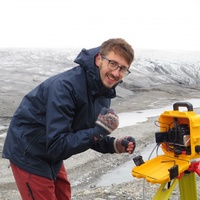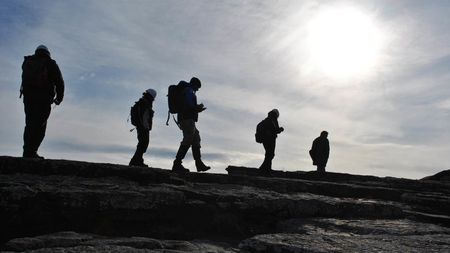
Interdisciplinary Fellow
- About
-
- Email Address
- william.harcourt@abdn.ac.uk
- Office Address
- School/Department
- School of Geosciences
Biography
I am Interdisciplinary Fellow at the University of Aberdeen leading the development of digital twin technology applied to the cryosphere. I graduated from the University of Exeter with a 1st Class Honours degree in Geography before moving to the University of Edinburgh to study for a MSc in Geographical Information Science (GIS). Between 2017 and 2018, I was a Research Assistant at Edinburgh Napier University where I led the first ever national scale analysis of seagrass change in the world. In 2022 I completed my PhD at the University of St Andrews where I developed millimetre-wave radar as a tool for mapping and monitoring glaciers. I then joined the University of Aberdeen in 2022 as a Lecturer before starting the interdisciplinary research fellowship in 2023.
My research interests span across multiple disciplines, including glaciology, remote sensing & Earth Observation, data science, artificial intelligence, Arctic science and many more. I work across several international organisations such as the Svalbard Integrated Arctic Earth Observing System (SIOS), the Association for Polar Early Career Scientists (APECS), and the Scottish Arctic Network (ScAN) amongst others. Through these roles I build new community tools, organise webinars & workshops and develop future science strategies/priorities. I also leave the office to work in the field. I have led and participated in several expeditions to locations such as Svalbard, Iceland, the European Alps, the Scottish Highlands and locally within the UK.
Qualifications
- BSc Geography2016 - University of Exeter
- MSc Geographical Information Science (GIS)2017 - University of Edinburgh
- PhD Physics2022 - University of St Andrews
External Memberships
- European Geosciences Union (EGU)
- American Geophysical Union (AGU)
- Royal Geographical Society (RGS)
- Remote Sensing & Photogrammetry Society (RSPSoc)
- Research
-
Research Overview
My research is highly interdisciplinary and covers subject areas in geographical sciences, computer sciences, physics and more! My research can be grouped into three main area:
Glaciology
- Glacier Dynamics: Processes influencing ice flow and its changes in a warming climate.
- Ice-Ocean Interactions: The process of iceberg calving and its contribution to mass loss across the Arctic.
- Arctic: I environments across the Arctic, particularly in Greenland and Svalbard, with a focus on glaciers and their interactions with the surrounding environment (terrestrial, marine, atmosphere)
Data Science/AI
- Digital Twins: Developing digital twins for chaotic environment systems such as glaciers (e.g. the Greenland Ice Sheet)
- Machine learning: Application of Artificial Intelligence (e.g. Machine Learning and Deep Learning) to study environmental systems (e.g. glaciers), often using remote sensing data.
- Observing Systems: Construction of inter-connected systems to observe environmental processes and document their changes over time.
- Data Science and Statistics: Development of data processing/analysis techniques for understanding environmental systems, error/uncertainty in environmental data.
Remote Sensing/Earth Observation (EO)
- Remote Sensing: Development of different sensors and techniques for mapping/monitoring environmental systems, particularly glaciers.
- Earth Observation: Harnessing large-scale satellite data for regional/global analysis of the Earth system.
- Database: Cataloguing available data for environmental research, particularly across the cryosphere.
Research Areas
Accepting PhDs
I am currently accepting PhDs in Geography and Environment, Computing Science.
Please get in touch if you would like to discuss your research ideas further.

Geography and Environment
Accepting PhDs
Computing Science
Accepting PhDsResearch Specialisms
- Glaciology and Cryospheric Systems
- Machine Learning
- Remote Sensing
Our research specialisms are based on the Higher Education Classification of Subjects (HECoS) which is HESA open data, published under the Creative Commons Attribution 4.0 International licence.
Current Research
- Greenland Ice Sheet Digital Twin (new for 2023!)
- Glacier and Ice Sheet Remote Sensing
- High-resolution Satellite Sensors (Small Satellites & Cubesats)
- Arctic Tidewater Glacier Dynamics (big focus right now on Ice Mélange and Sea Ice)
Supervision
Supervisees
- MR STEVEN WALLACE
- MR JACOB SESTON
- Publications
-
Page 1 of 2 Results 1 to 10 of 16
Automated Crevasse Mapping Using Deep Learning Foundation Models to Analyse Climate Change and Glaciology
Contributions to Conferences: Oral Presentations- [ONLINE] DOI: https://doi.org/10.5194/egusphere-egu24-12922
Surge initiation at the terminus of Borebreen (Svalbard): Drivers and impact on calving
Contributions to Conferences: Oral Presentations- [ONLINE] DOI: https://doi.org/10.5194/egusphere-egu24-1505
3D terrain mapping and filtering from coarse resolution data cubes extracted from real-aperture 94 GHz radar
IEEE Transactions on Geoscience and Remote Sensing, vol. 62, 5102218Contributions to Journals: Articles- [ONLINE] DOI: https://doi.org/10.1109/TGRS.2024.3353676
94 GHz Radar Backscatter Characteristics of Alpine Glacier Ice
Geophysical Research Letters, vol. 50, no. 21, e2023GL104721Contributions to Journals: ArticlesHansbreen’s calving-driven ice loss derived from seismic data supported by millimetre-wave radar scans and neural networks
EGU General Assembly 2022, pp. EGU22-4179Contributions to Conferences: AbstractsWhere to fish in the forest?: Tree characteristics and contiguous seagrass features predict mangrove forest quality for fishes and crustaceans
Journal of Applied Ecology, vol. 60, no. 7, pp. 1340-1351Contributions to Journals: ArticlesGlacier monitoring using real-aperture 94 GHz radar
Annals of Glaciology, vol. 63, no. 87-89, pp. 116-120Contributions to Journals: ArticlesAssessment of ice mélange impacts on tidewater glacier dynamics using high resolution ICEYE imagery
Contributions to Conferences: Oral PresentationsMillimetre-wave radar observations of glacier calving at Hansbreen (Svalbard) correlated with TLS, time-lapse camera images and seismic records
Contributions to Conferences: Oral PresentationsObserving iceberg size distributions and implications for calving processes
Contributions to Conferences: Oral Presentations
